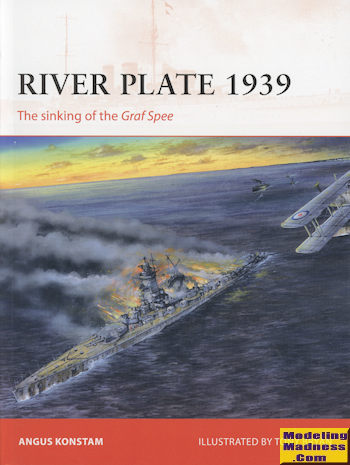Osprey's River Plate 1939
|
Author: |
Angus Konstam, illustrated by Tony Bryan |
|
Publisher/Distributor |
Osprey Publishing |
|
Price |
$24.00 MSRP |
|
Reviewer: |
Scott Van Aken
|
|
Notes: |
96 pages, 7¼ x 9¼ inches, softcover
ISBN:978-1-4728-1795-2 |
 At the
beginning of WWII, the German navy was not what you'd call a 'seven seas' force.
It was basically designed for two functions. One was to keep control of the
Baltic with its routes to Sweden for raw materials. The other was for commerce
raiding. Most of us think of submarines when it comes to commerce raiding, and
truly, for the money, submarines were the best method. However, the Germans also
had a small, but potent surface fleet. In particular, three small cruiser size
vessels armed with battleship size guns. One of these was the Graf Spee,
probably the most successful of the three ships, and also the one with the
shortest wartime career.
At the
beginning of WWII, the German navy was not what you'd call a 'seven seas' force.
It was basically designed for two functions. One was to keep control of the
Baltic with its routes to Sweden for raw materials. The other was for commerce
raiding. Most of us think of submarines when it comes to commerce raiding, and
truly, for the money, submarines were the best method. However, the Germans also
had a small, but potent surface fleet. In particular, three small cruiser size
vessels armed with battleship size guns. One of these was the Graf Spee,
probably the most successful of the three ships, and also the one with the
shortest wartime career.
Along with the
Deutchland, she was at sea at the start of the war. The Deutchland was not
particularly successful with only three ships to her credit during this sortie,
but she did arrive back in Germany were she was promptly renamed the Lutzow.
The Graf Spee, on
the other hand, headed for the South Atlantic and operated in those waters and
in the western Indian Ocean, where she was able to sink nine ships. At this time
in the war, ships were stopped, verified to be enemy and then, once the crews
were taken off the ship, the ships were sunk. This was not the case later in the
war.
The major purpose of
ocean raiders such as the Graf Spee was to tie up enemy ships hunting for them.
This is something the Graf Spee did particularly well with several small forces
of British and French ships hunting the oceans for her. To keep ahead of these
forces, the Graf Spee had to attack and then head elsewhere. She was under
orders not to engage enemy ships, though her heavy armament could make quick
work out of both light and heavy cruisers should the need arise.
This, of course,
required the Graf Spee to be outside of the range of enemy warships should this
ever happen. For some unexplained reason, this did not occur and when confronted
by the British heavy cruiser Exeter and the light cruisers Ajax and Achillies,
the Graf Spee was damaged by their smaller guns, though the Graf Spee caused
serious damage to the Exeter and lesser degrees of damage to the Ajax and
Achilles during their battle.
Fearing larger ships
on the way, the captain of the Graf Spee headed for the nearby port of
Montivideo, Uruguay and the rest is history.
Typical of this series, the author covers
some of the background of the panzerschiff line as well as the pre and early war
situation. Most of the book covers the operations of the Graf Spee and her
stores ship the Altmark. The opponents are also covered in some detail: both the
men and the ships. There are a considerable number of great period photos and
the artwork and maps really help to bring the battle alive. If you are a fan of
things nautical or just interested in this particular event, then this is a book
for you.
22 September 2016
Copyright
ModelingMadness.com
For more on the complete line of Osprey books,
visit www.ospreypublishing.com
.
If you would like your product reviewed fairly and fairly quickly, please
contact
the editor or see other details in the
Note to
Contributors.
 At the
beginning of WWII, the German navy was not what you'd call a 'seven seas' force.
It was basically designed for two functions. One was to keep control of the
Baltic with its routes to Sweden for raw materials. The other was for commerce
raiding. Most of us think of submarines when it comes to commerce raiding, and
truly, for the money, submarines were the best method. However, the Germans also
had a small, but potent surface fleet. In particular, three small cruiser size
vessels armed with battleship size guns. One of these was the Graf Spee,
probably the most successful of the three ships, and also the one with the
shortest wartime career.
At the
beginning of WWII, the German navy was not what you'd call a 'seven seas' force.
It was basically designed for two functions. One was to keep control of the
Baltic with its routes to Sweden for raw materials. The other was for commerce
raiding. Most of us think of submarines when it comes to commerce raiding, and
truly, for the money, submarines were the best method. However, the Germans also
had a small, but potent surface fleet. In particular, three small cruiser size
vessels armed with battleship size guns. One of these was the Graf Spee,
probably the most successful of the three ships, and also the one with the
shortest wartime career.